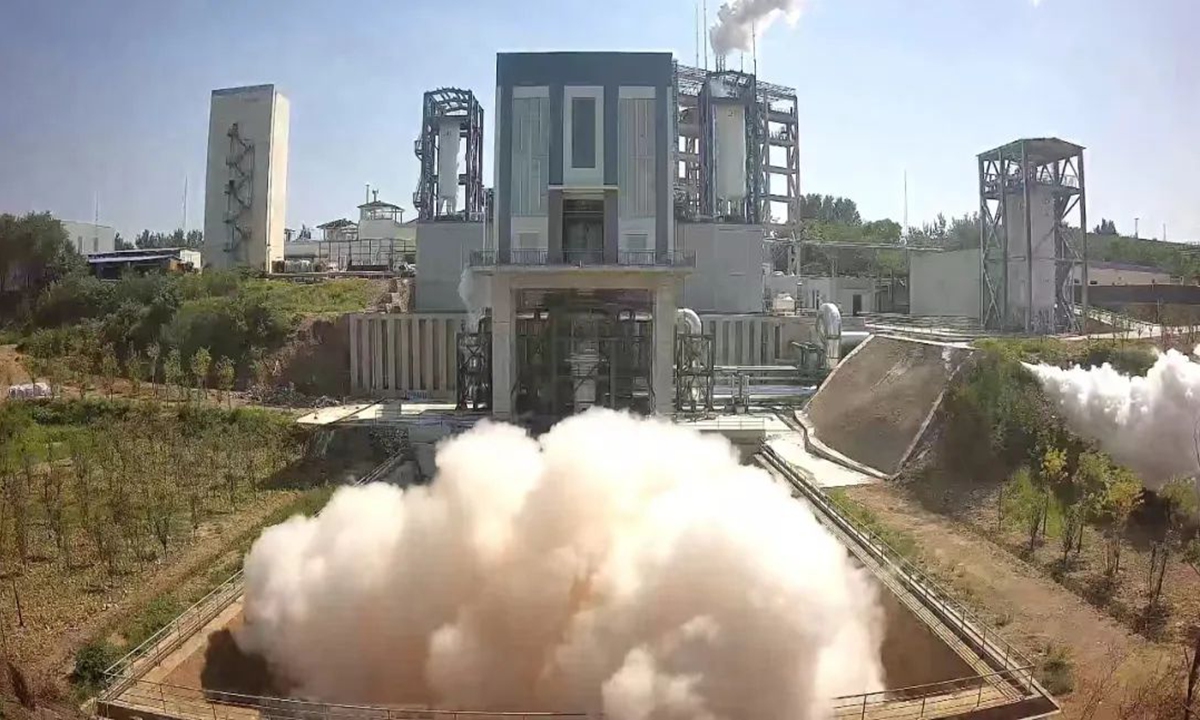China's new-gen manned launch vehicle completes first high-altitude simulation test, paves way for crewed lunar exploration

China's new-gen manned launch vehicle completes its first high-altitude simulation test. (Photo: Courtesy of the Sixth Academy of China Aerospace Science and Technology Corporation)
China has achieved another significant milestone in its development of the new-generation manned carrier rocket, with the successful completion of a long-duration high-altitude simulation test for the vehicle's third-stage liquid hydrogen and liquid oxygen engine, the Global Times learned on Tuesday.
The test has verified the feasibility of the rocket engine working for long periods in space, laying a solid foundation for the smooth progress of the country's future lunar manned exploration program, industry insiders said.
The test was conducted on a newly constructed vertical high-altitude simulation test stand, the first of its kind in China and the longest-duration hydrogen-oxygen engine high-altitude simulation test stand internationally, the Global Times learned from the Sixth Academy of China Aerospace Science and Technology Corporation (CASC).
The successful completion of this long-duration test suggests that the vehicle's engine achieved the milestone of a thousand-second level test capability, representing a substantial improvement in China's liquid rocket engine testing technology.
This development will significantly support the smooth progression of China's manned lunar exploration program, the Sixth Academy said in a statement.
The CASC previously disclosed that the new-generation manned carrier rocket is expected to possess the capability of sending payload of 27 tons to the Earth-lunar transfer orbit and that of 70 tons to near-Earth orbit.
The new powerful rocket is expected to be ready for its maiden flight by 2027, according to the CASC.
China's lunar exploration program has been advancing steadily with its "circle of friends" continuing to expand. A research institute in Hungary has recently become the latest partner to join the China and Russia co-led International Lunar Research Station (ILRS), which aims to build a permanent base on the moon around 2035.
The Hungarian Solar Physics Foundation had signed a memorandum of understanding on ILRS cooperation with China's Deep Space Exploration Laboratory, during which it expressed its intention to strengthen cooperation with China in the area of deep space exploration, according to the lab's official WeChat account on July 19.
The joining of this organization from Hungary - both an EU and NATO member - has brought the total number of ILRS partners to around 25, according to media reports.
The Hungarian Solar Physics Foundation holds significant influence in the fields of solar physics and heliophysics and has been engaging in extensive collaborations with numerous universities and research institutions, including the Chinese Academy of Sciences and the University of Science and Technology of China.
It is worth noting that Turkey is reportedly the first NATO member state to apply to join the ILRS project at a national level.
According to a report by Russia's TASS news agency in April, Anatoly Petrukovich, director of the Space Research Institute of the Russian Academy of Sciences, said that Turkey has submitted an application to participate in the ILRS project led by China and Russia.
Photos
Related Stories
- Xinjiang scientists discover plant with potential to survive on Mars
- China's first commercial space launch site gears up
- Major records of China's space station spacewalks
- Chinese lab, company to develop "space computing constellation"
- South China's Hainan speeds up layout of aerospace industry
- Chinese scientists report progress in rare metals research aboard space station
Copyright © 2024 People's Daily Online. All Rights Reserved.









